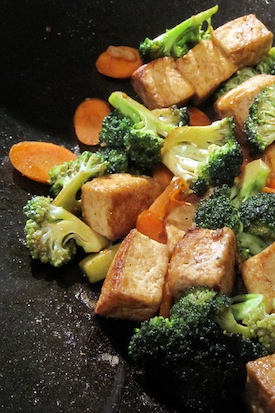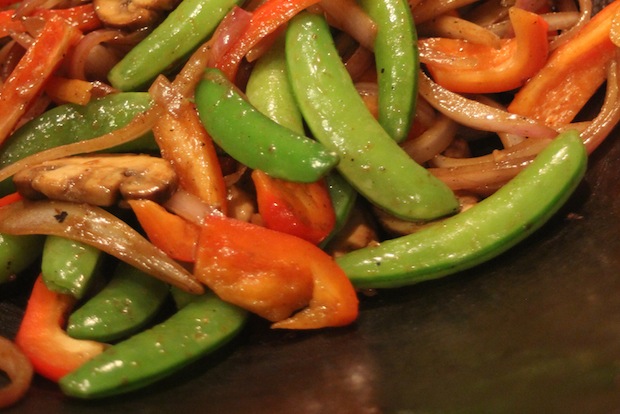Stir fry is one of those meals that withstands—and even relishes—improvisation. Pretty much any vegetable or protein is fair game, and you can nearly throw the kitchen sink into the sauce. It’s become one of the go-to meals my husband gravitates towards when it’s his turn to cook, and I must admit that he has become quite the masterful stir fry sauce creator. After desperate pleas to let me write down the ingredients of his sauces so my friends and I might have some chance of recreating some of his most flavorful sauces (usually he just throws things in without measuring), I managed to snag two, now tested on numerous occasions.
The first sauce has an amazing complexity of flavors; it’s salty, tart, spicy, sweet, fatty/meaty/savory (let’s call it umami-y?), and complements broccoli particularly well. As a matter of fact, my friend Jon’s seven-year-old son, Simon, has recently decided that stir fry is his favorite food, largely owing to his love of this sauce. The first time Jon made the stir fry with tofu and broccoli he told me that he let Simon (then six) try a bite, asking him if he still liked the sauce. Simon replied, “Oh. Yeah. I like this sauce. I think it really makes the stir fry.” I love you, Simon.The tamarind and grenadine were surprising ingredients to me, and I would imagine this sauce would still be tasty without either of the ingredients. But, as Dan put
it, he added the grenadine to balance out the tartness of the tamarind (which he was apparently determined to include). The inclusion of all these ingredients is how a simple stir fry results in the aforementioned long list of adjectives.
Recipe: Savory Stir Fry Sauce No. 1
Ingredients
- 2 tbs light soy sauce
- 1 tbs rice vinegar
- 1 tbs toasted sesame oil
- 1/2 tsp tamarind paste
- 1/2 tsp grenadine
- 1 tbs ground coriander
- 1 tsp ground ginger
Instructions
- Prepare sauce before cooking any of the vegetables.
- Stir fry your choice of protein and vegetables (preferably with a lot of minced garlic) in about a tablespoon of oil.
- Once everything is cooked, add the sauce to the pan and stir, cooking for about one minute to let the flavors meld.
- Serve over rice as desired.
Number of servings (yield): 4
The second sauce was Dan’s response to my hope for a stir fry with less sodium than is usually found in stir fry sauces. Ironically, it turns out this sauce has the same amount of light soy sauce as the first sauce! I’m still glad I asked for something “different,” though, because it resulted in a delightfully rich and flavorful sauce. (Don’t get me wrong. These sauces are still not low sodium sauces. They are, however, less than usual and definitely less sodium than you’d find in prepared foods.) The balsamic vinegar adds both a little sweetness and tartness, and the ground spices add an earthy depth.
Recipe: Savory Stir Fry Sauce No. 2
Ingredients
- 2 tbs light soy sauce
- 2 tbs balsamic vinegar
- 1 tsp molasses
- a “decent squirt” of Sriracha (preferably the brand with the rooster on it)
- 4-5 garlic cloves, minced
- 1 tbs ground coriander
- 2 tsp ground ginger
- 1 tsp ground sage
- a few squirts Vietnamese fish sauce (I think we used vegetarian “food” sauce)
Instructions
- Prepare sauce in advance of cooking anything, since time is of the essence once stir frying.
- Stir fry your choice of vegetables and protein. When veggies are almost cooked, add sauce, toss to coat thoroughly, and cover for a minute or so. Test doneness and repeat stirring and covering until vegetables are cooked.
Number of servings (yield): 4
Since there is raw garlic in the sauce, you do need to cook this sauce a little bit more than Sauce No. 1, making it important to add the sauce while the veggies are still just slightly undercooked (unless you like raw garlic, of course!).



I now know what I’m preparing for dinner tonight! I think I’ll mix up each of these sauces so we can taste them both.
I love the idea of using grenadine as an ingredient!
Hope you enjoyed them, Jeff! Any suggestions for improvements or variations? (If you even remember – I’m so sorry for the slow response, but somehow I didn’t get the notification about your comment. Apparently I have some kinks to work out… Hope you guys are doing well!)
Hope you guys are doing well!)
They were both very good, and both went very well with my stir fried vegetables and chicken. It’s been so long I’ve forgotten the differences in taste, but I enjoyed using odd (to me) ingredients like grenadine and molasses in this kind of cooking.
I ground my coriander seeds very roughly because I like the texture.
Although I didn’t add it this time, I like adding a little white ground pepper to Asian dishes. I may add a dash next time.
Hope all’s well!
Tonight, I couldn’t find a suitable tamarind paste in the house, so I decided to try making your sauce #1 with amchur (powdered mango). It was quite nice! I also like to add a little more spice to this one–usually just red pepper flakes, though there are probably other good options.
Every time we make this, we wish there was extra sauce—some of it usually ends up getting cooked off when I add it at the end and there’s rarely enough to sufficiently flavor the vegetables, protein and rice all together. Any hints for that, beyond just doubling the recipe?
Do you think the sauce has enough flavor, but just that it evaporates? If so, you could just add some water, the miracle “free” ingredient! I don’t know why this was such an epiphany in culinary school, but it totally was. Still boggles my mind sometimes (just don’t add water to chocolate!).
Oh, brilliant! That makes sense. So you have to push yourself over the edge of worrying that the water will dilute the flavor… since you already know that a lot of it will evaporate! I think I understand why that seems counterintuitive at first—you are trying to make the perfect sauce, and you are “diluting it”—but you have to see beyond its initial form. Magic!